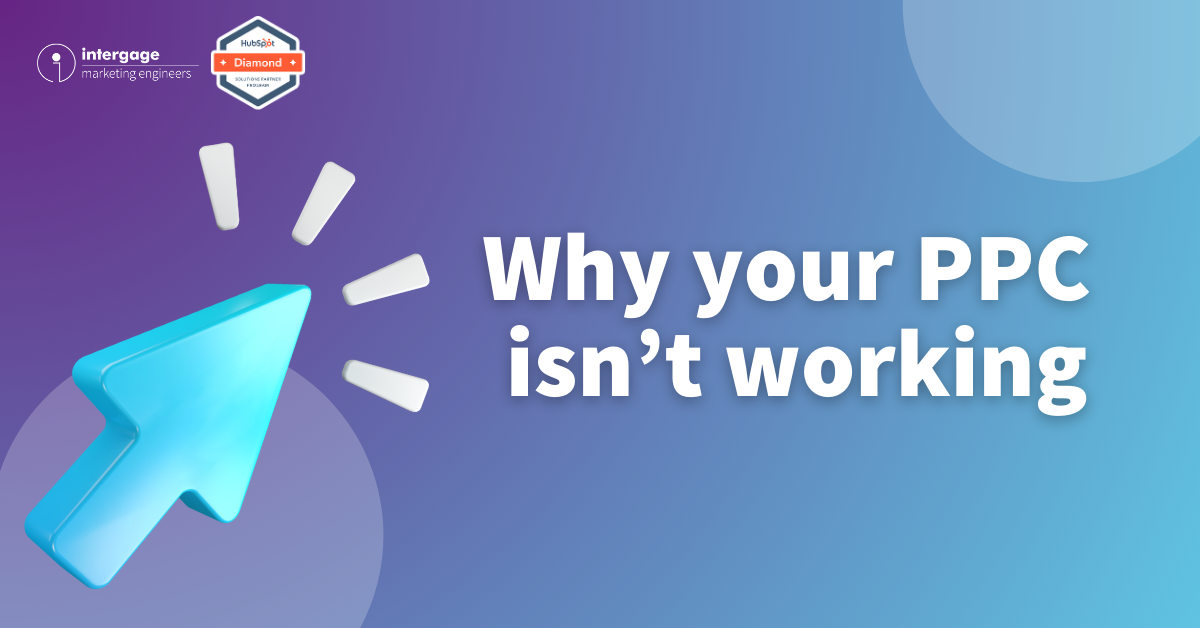How Much Is Attracting The Wrong Audience Costing You?
Hidden Strategic Dangers
This problem of wrong audiences goes way deeper than you realise. It’s about more than just wasted PPC clicks (though that’s costly enough).
Pulling in the wrong visitors leaves you exposed and vulnerable as you face some grim strategic problems...
Your PPC budgets were already stretched. Now they’re at breaking point because you’re wasting money (and time) on pointless clicks that will never convert. It’s heartbreaking – especially when cost per click is rising due to ever-increasing competition.
To make matters worse, your overall marketing budget is suffering because your MD cut it (even though that’s a foolish idea).
Does this sound worryingly familiar? At times like these, every click has to count. Whether you’re paying for them or not…
SEO Dangers Of Attracting The Wrong Crowd
You may think there’s no harm in the wrong audiences finding your site organically: “Hey, it’s not PPC, I’m not paying for them…what’s the problem?”
But you’d be mistaken. Rolling out the red carpet for every Tom, Click and Harry – regardless of whether they’re truly right for you – can do real damage to your SEO and your Google rankings. Here’s the issue…
Google is more than a search engine: it is effectively a guide to website quality – and it knows it. Being the number one search engine makes it a powerful arbiter elegantiae of website quality. After all, Google’s reputation would suffer if it ranked poor quality sites high on page one (simply because they fulfilled other technical SEO criteria).
So Google judges each web page’s Expertise, Authoritativeness and Trustworthiness (EAT). Especially if it’s a Your Money Or Your Life (YMYL) website covering topics such as:
- news and current events, government, law, finance
- health and safety
- groups based on diversity
- fitness, nutrition
- housing information, education, finding a job and so on…
And if your website has a poor record of keeping visitors engaged (ie, if they’re the wrong traffic), then Google will downrank your pages.
Intent, Intent, Intent!
Your website should be filled with 10X pages that exude quality and authority. They should be veritable goldmines of content for users hungry for answers. And above all they must be relevant. Ultra-relevant.
SEO tactics change as often as Google’s algorithm but one thing never goes out of style. Relevancy.
So scrutinise your keywords and copy painstakingly to ensure they’re attracting precisely the visitors you need. Not just tyre kickers, brain robbers and other associated time-wasters. Beware of keywords that are too broad. Beware of keywords that do not chime exactly with your desired prospects’ intent.
.png?width=1200&name=Blog%20Social%20Posts%20(19).png)
Dig Into Your Google Analytics!
Take a long hard look at your Google Analytics. How engaged are your visitors? How many pages are they looking at on average? How long are they spending on each session/visit?
Google has consistently said that it does not take bounce rate into consideration when ranking web pages. After all, there are positive bounces: visitors arrive on a page, get the information they want then leave immediately. Your Contact Us page is a prime example of this.
But that doesn’t mean you should ignore your bounce rate. Quite the contrary. It’s a very good indicator of audience quality. It’s time to segment, segment, segment…
Mind Your Language!
Look at location and language. Your bounce rate may be high because you’re attracting a lot of visitors who don’t speak English; they take one look at your pages and immediately bounce out because they don’t understand the text.
It’s worth reviewing the hreflang tags on your website. These tags tell search engines about the language (and location) of your site. You may wonder why Google needs to be told your site’s language when it’s getting much better at translating a plethora of obscure tongues and dialects.
But you’d be surprised. It’s worth using hreflang tags to show Google that your site is written in ‘en-gb’ (British English) rather than ‘en-us’ (American English) – or ‘de-de’ (German), rather than ‘de-at’ (Austrian) or ‘de-ch’ (Swiss German). Every little helps.
That splendid SEO tool SEMRush analysed 20,000 websites with multiple language versions. It revealed a multitude of hreflang errors:
- 45% had the wrong country code – ie, ‘en-uk’ (’uk’ is the code for Ukraine)
- 40% had the wrong language code – ie, ‘eng-gb’ (wrong) rather than ‘en-gb’ (correct)
- 23% used an underscore instead of a dash – ie, ‘en_uk’ (wrong)
- 20% used only the country code – ‘?-gb’
- 3% used the language and country in the wrong order – ‘gb-en’ (wrong) instead of ‘en-gb’ (correct).
Wasted PPC Clicks, Squandered Impression Share
Unwanted PPC clicks are bad enough but attracting the wrong paid audiences can also reduce your impression share (ie, how often your ads are showing).
If your impression share is 50% then your ads are showing only half the time. You’re fishing only half the pond. Maybe because:
- your campaign budgets aren’t high enough (but don’t raise your budgets if you’re wasting clicks – you need to put out the fire first, not throw petrol on it!)
- you’re not bidding enough and you’re getting outranked in the ad auction
- your keyword quality scores are poor – due to low clickthrough rates, poor ad relevance and mediocre landing pages – so you’re getting outranked again.
Google’s Negative Attitude To Search Terms
Your PPC may be pulling in the wrong crowd because you’re not using enough negative keywords (or negative dynamic ad targets) to exclude irrelevant traffic.
But identifying those important negative keywords has never been harder – because Google now shows you only a paltry number of search terms.
So it can feel as if you’re flying blind: in some instances, Google Ads can make it virtually impossible to identify and neg out unwanted traffic. If search terms were small furry animals, Sir David Attenborough would be highlighting their tragic near-extinction in some accounts.
Meanwhile, Google is laughing all the way to the bank (seemingly oblivious to the fury of its advertisers over such a cynical power-ploy).
And yet there are ways to help counter the problem of dwindling search terms. All is not completely lost if you turn to Google Analytics, Google Search Console and various other handy tools/methods.
Are Your PPC Keywords, Ad Scheduling And Location Targeting Wrong?
There could be other possible issues with your PPC:
- some of your keywords are wrong – preventing the right keywords from showing enough (due to lost impression share)
- you’re not using ad scheduling properly – do you really want all those 1am-4am non-converters using up your click budgets and impression share?
- your location targeting may be overly optimistic – focus budget on your core converting areas.
Furthermore, are you targeting the wrong devices, audiences or demographics? Exclude traffic that does not convert or play a role in assisting conversions.
All of this matters. Especially if you’re finding SEO more challenging and are therefore relying on PPC to help plug gaps in your traffic.
So double down on the PPC traffic that you know works. And consider remarketing to your most engaged audiences.
.png?width=1200&name=Blog%20Social%20Posts%20(20).png)
Wrong Referrals (And Links From Wrong’Uns)
This is a huge topic in its own right, one that has sparked plenty of debate among SEOs. They have penned acres of copy about negative SEO, referrals from poor quality sites and disavowing bad links.
But over recent years, Google’s algorithm has mellowed with regard to bad links. Google’s John Mueller has played down the need to disavow them. Most firms won’t need to do so, he says.
That shouldn’t stop you from checking your technical SEO from time to time and doing basic housekeeping where needed.
Direct Traffic Spam
You’d hope that someone searching for you by name isn’t going to be a plonker. Sadly, this is not always the case.
Look hard at your direct traffic. Has the bounce rate increased? Do you see one-day spikes in direct traffic? If so, you may be falling victim to direct traffic spam.
Segment your analytics by country, by city. Are you seeing lots of visits lasting less than a second? Do they have 100% bounce rate? If so, it’s a fair bet that your site is being scraped by a bot or tool (in every sense of the word).
You may discover that many of those spam visits are coming from Chicago or Boardman in the USA.
At best it is mucking up your analytics. And you can filter those visits out. But all you’re doing is removing them from an analytics view: they’re still arriving at your site.
Google Analytics has bot filtering. And there are tools out there that claim to stop the problem.
But to stop the problem at source, you may need to block the traffic from your server.
Social Media Traffic
How can I put this politely? Social media is not exactly the great conversion-fest it was cracked up to be when it first appeared all those years ago.
Your social media bounce rate is probably higher than it is are for other channels. And the conversion rate is probably lower. Not exactly the ‘seven times higher’ conversion rate figure first punted around in the early days.
Your social media audience may like and trust you because you connected with them. But that doesn’t guarantee they’ll be queuing up to buy though.
Just because they’re avidly consuming content, it doesn’t mean they’ll automatically convert by filling in a form. Not every lingering glance leads to a first date.
But social media is important. It builds trust – and your public expects you to have a decent social media presence. It’s a given.
Not having social media is like not having a phone. (Though Lush binned social media after becoming frustrated at how uncooperative the platforms’ algorithms were becoming.)
So you persevere. Social media may sometimes feel like a wrong audience if you look at the numbers in pure isolation.
But if you do social media the right way – if you’re unselfish, friendly and helpful – it will help to drive conversions across your various channels.
Can Traffic Be Wrong If It Converts?
Yes – if the leads don’t translate into real cash-in the-bank business.
Spurious leads can be some of the most frustrating wrong traffic because of all the time they waste.
It takes an average six to eight touchpoints to secure a sale. That’s a lot of time wasted on emails, phone calls, proposals, Zoom meetings and admin if the lead eventually turns out to be ‘not the right fit’.
Even politely jettisoning them at the Marketing Qualified Lead (MQL) or Sales Qualified Lead (SQL) stage still involves wasted time and energy.
It would have been better not to have attracted them in the first place. Save your precious and finite resources for leads that really count.
How Bad Is My Audience? Get Expert Help
Without detailed research, you’ll never know how much damage bad traffic is doing to your PPC bank balance and website SEO.
Or how much that’s holding you back compared with your competitors.
A Marketing Opportunity Analysis will give you all the answers. It’s an in-depth examination of your online presence and how it compares with your rivals.
Learn how an MOA can benefit your business.
Get A Free Competitive Report
When did you last benchmark your website’s performance against your competitors?
- Would you like to know the top keywords they’re using?
- Or how much of the available online market share those keywords are giving them?
- Or how you’re ranking for the top keywords (compared with your rivals)?
Get a FREE competitive report to find out more…




